Equality and Diversity Challenges in the Workplace: A ZARA Study
VerifiedAdded on 2023/01/11
|30
|6388
|87
Report
AI Summary
This report examines the implementation of equality and diversity in the workplace, focusing on the benefits, challenges, and best practices through a case study of ZARA, a leading British fashion retailer. The report begins with an introduction to project management, outlining its key stages and benefits, and then delves into a literature review exploring the concepts of equality and diversity, the challenges they present, and the significance of maintaining them in the workplace. The research methodology employs a qualitative approach using interpretivism and inductive reasoning for data collection and analysis. The data analysis section presents findings and recommendations for ZARA to overcome equality and diversity issues. The conclusion summarizes the key findings and provides actionable recommendations. Finally, a reflection on the learning experience is included.

MANAGING A SUCESSFUL
BUSINESS
BUSINESS
Paraphrase This Document
Need a fresh take? Get an instant paraphrase of this document with our AI Paraphraser

Table of Contents
INTRODUCTION...........................................................................................................................3
LO 1.................................................................................................................................................4
Project management description..................................................................................................4
Key stages of project management..............................................................................................4
Pros of using project management and its important...................................................................5
LO 2.................................................................................................................................................7
Literature review..............................................................................................................................7
Theme 1- Comprehending equality and diversity concept..........................................................7
Theme 2- Varied challenges at workplace offered by equality & diversity................................8
Theme 3- Significance of maintaining diversity and equality at work area................................8
Research methodology.....................................................................................................................9
Research type...............................................................................................................................9
Research philosophy....................................................................................................................9
Research approach.......................................................................................................................9
Data Collection..........................................................................................................................10
Data Analysis.............................................................................................................................10
Ethical Consideration.................................................................................................................10
DATA ANALYSIS.......................................................................................................................11
LO 3...............................................................................................................................................22
Conclusion.................................................................................................................................22
Recommendations......................................................................................................................23
LO 4...............................................................................................................................................24
Reflection...................................................................................................................................24
INTRODUCTION...........................................................................................................................3
LO 1.................................................................................................................................................4
Project management description..................................................................................................4
Key stages of project management..............................................................................................4
Pros of using project management and its important...................................................................5
LO 2.................................................................................................................................................7
Literature review..............................................................................................................................7
Theme 1- Comprehending equality and diversity concept..........................................................7
Theme 2- Varied challenges at workplace offered by equality & diversity................................8
Theme 3- Significance of maintaining diversity and equality at work area................................8
Research methodology.....................................................................................................................9
Research type...............................................................................................................................9
Research philosophy....................................................................................................................9
Research approach.......................................................................................................................9
Data Collection..........................................................................................................................10
Data Analysis.............................................................................................................................10
Ethical Consideration.................................................................................................................10
DATA ANALYSIS.......................................................................................................................11
LO 3...............................................................................................................................................22
Conclusion.................................................................................................................................22
Recommendations......................................................................................................................23
LO 4...............................................................................................................................................24
Reflection...................................................................................................................................24

REFERENCES..............................................................................................................................26
⊘ This is a preview!⊘
Do you want full access?
Subscribe today to unlock all pages.

Trusted by 1+ million students worldwide

INTRODUCTION
Equality and diversity implement in workplace by management will provide many
benefits as it help to enhance productivity level rather than before. There is varied benefits
organizations gain due to these two elements. There are different types of techniques and
methods accessible in market or corporate sector used by many firms to implement and manage
equality and diversity at workplace.
The current study is based on ZARA, is leading British Fashion in the world operating
their business across UK with skilled, knowledgeable and talented applicants. To overcome
diversity and equality problems at work area management of this company conduct a lot of
research and practices as well. That is the main reason for which research chose this company
because it relates to current topic that is to uncertain several measures which can be aid
organization to overcome problems of equality & diversity at place where people are working
together.
Aim-
To uncertain different measure which can help the company in overcoming the issues of
equality and diversity at the workplace. A study based on ZARA.
Objectives-
To understand the concept of Equality and Diversity
To analyse different challenges offered by Equality and Diversity at the workplace
To examine what is the importance of maintain Equality and Diversity at workplace.
To recommended the best way through which company may overcome the issue of
Equality and Diversity.
Equality and diversity implement in workplace by management will provide many
benefits as it help to enhance productivity level rather than before. There is varied benefits
organizations gain due to these two elements. There are different types of techniques and
methods accessible in market or corporate sector used by many firms to implement and manage
equality and diversity at workplace.
The current study is based on ZARA, is leading British Fashion in the world operating
their business across UK with skilled, knowledgeable and talented applicants. To overcome
diversity and equality problems at work area management of this company conduct a lot of
research and practices as well. That is the main reason for which research chose this company
because it relates to current topic that is to uncertain several measures which can be aid
organization to overcome problems of equality & diversity at place where people are working
together.
Aim-
To uncertain different measure which can help the company in overcoming the issues of
equality and diversity at the workplace. A study based on ZARA.
Objectives-
To understand the concept of Equality and Diversity
To analyse different challenges offered by Equality and Diversity at the workplace
To examine what is the importance of maintain Equality and Diversity at workplace.
To recommended the best way through which company may overcome the issue of
Equality and Diversity.
Paraphrase This Document
Need a fresh take? Get an instant paraphrase of this document with our AI Paraphraser

LO 1
Project management description
It is one of the best practices of leading and managing work of group of members who
are able to achieve set aims and objectives of research project and meet success criteria at
particular time (Martens and Carvalho, 2017). It is the mode researcher manages and organizes
available resources that are important to complete a project. Project management is also
considered as application of skills, knowledge, techniques and tools to project activities to meet
tasks requirements. Its procedure includes few stages such as initiating, planning, executing,
controlling & monitoring and closing. Project management knowledge draws on 10 specific
areas such as integration, scope, time, cost, procurement, quality, human resources, risk
management, shareholder administration and communications.
All management is focused with these elements but project management brings a
different concentrate by aims, schedule and resources of work. In context of research, project
management is also a important transferable ability that can be utilize within broader workforce.
It is one of the best tools person can use to make their research project as success it includes
several of techniques for managing work including suggestions for common project management
systems. It is defined as important practice that applied knowledge of procedures.
Key stages of project management
Initiation-
It is the first stage of project management where work feasibility and value are measured.
It is usually utilize two evaluation techniques to decide whether or not to follow a task (Samset
and Volden, 2016).
Planning-
This is the second phase which is quite essential and beneficial while completing a
project. After getting conformation project manager take one set a head and creates effective
plan to direct their team in order to accomplish work.
Execution-
Project management description
It is one of the best practices of leading and managing work of group of members who
are able to achieve set aims and objectives of research project and meet success criteria at
particular time (Martens and Carvalho, 2017). It is the mode researcher manages and organizes
available resources that are important to complete a project. Project management is also
considered as application of skills, knowledge, techniques and tools to project activities to meet
tasks requirements. Its procedure includes few stages such as initiating, planning, executing,
controlling & monitoring and closing. Project management knowledge draws on 10 specific
areas such as integration, scope, time, cost, procurement, quality, human resources, risk
management, shareholder administration and communications.
All management is focused with these elements but project management brings a
different concentrate by aims, schedule and resources of work. In context of research, project
management is also a important transferable ability that can be utilize within broader workforce.
It is one of the best tools person can use to make their research project as success it includes
several of techniques for managing work including suggestions for common project management
systems. It is defined as important practice that applied knowledge of procedures.
Key stages of project management
Initiation-
It is the first stage of project management where work feasibility and value are measured.
It is usually utilize two evaluation techniques to decide whether or not to follow a task (Samset
and Volden, 2016).
Planning-
This is the second phase which is quite essential and beneficial while completing a
project. After getting conformation project manager take one set a head and creates effective
plan to direct their team in order to accomplish work.
Execution-
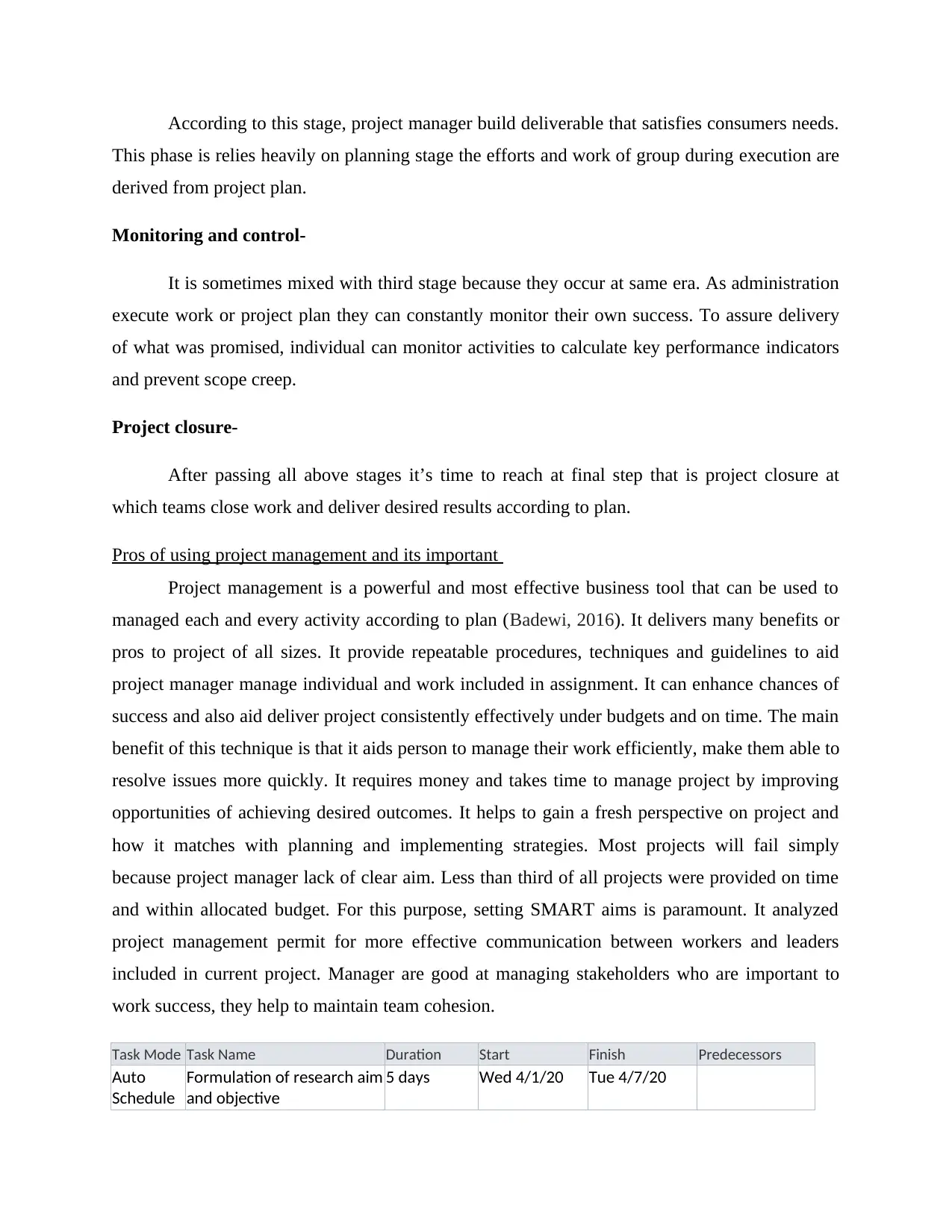
According to this stage, project manager build deliverable that satisfies consumers needs.
This phase is relies heavily on planning stage the efforts and work of group during execution are
derived from project plan.
Monitoring and control-
It is sometimes mixed with third stage because they occur at same era. As administration
execute work or project plan they can constantly monitor their own success. To assure delivery
of what was promised, individual can monitor activities to calculate key performance indicators
and prevent scope creep.
Project closure-
After passing all above stages it’s time to reach at final step that is project closure at
which teams close work and deliver desired results according to plan.
Pros of using project management and its important
Project management is a powerful and most effective business tool that can be used to
managed each and every activity according to plan (Badewi, 2016). It delivers many benefits or
pros to project of all sizes. It provide repeatable procedures, techniques and guidelines to aid
project manager manage individual and work included in assignment. It can enhance chances of
success and also aid deliver project consistently effectively under budgets and on time. The main
benefit of this technique is that it aids person to manage their work efficiently, make them able to
resolve issues more quickly. It requires money and takes time to manage project by improving
opportunities of achieving desired outcomes. It helps to gain a fresh perspective on project and
how it matches with planning and implementing strategies. Most projects will fail simply
because project manager lack of clear aim. Less than third of all projects were provided on time
and within allocated budget. For this purpose, setting SMART aims is paramount. It analyzed
project management permit for more effective communication between workers and leaders
included in current project. Manager are good at managing stakeholders who are important to
work success, they help to maintain team cohesion.
Task Mode Task Name Duration Start Finish Predecessors
Auto
Schedule
Formulation of research aim
and objective
5 days Wed 4/1/20 Tue 4/7/20
This phase is relies heavily on planning stage the efforts and work of group during execution are
derived from project plan.
Monitoring and control-
It is sometimes mixed with third stage because they occur at same era. As administration
execute work or project plan they can constantly monitor their own success. To assure delivery
of what was promised, individual can monitor activities to calculate key performance indicators
and prevent scope creep.
Project closure-
After passing all above stages it’s time to reach at final step that is project closure at
which teams close work and deliver desired results according to plan.
Pros of using project management and its important
Project management is a powerful and most effective business tool that can be used to
managed each and every activity according to plan (Badewi, 2016). It delivers many benefits or
pros to project of all sizes. It provide repeatable procedures, techniques and guidelines to aid
project manager manage individual and work included in assignment. It can enhance chances of
success and also aid deliver project consistently effectively under budgets and on time. The main
benefit of this technique is that it aids person to manage their work efficiently, make them able to
resolve issues more quickly. It requires money and takes time to manage project by improving
opportunities of achieving desired outcomes. It helps to gain a fresh perspective on project and
how it matches with planning and implementing strategies. Most projects will fail simply
because project manager lack of clear aim. Less than third of all projects were provided on time
and within allocated budget. For this purpose, setting SMART aims is paramount. It analyzed
project management permit for more effective communication between workers and leaders
included in current project. Manager are good at managing stakeholders who are important to
work success, they help to maintain team cohesion.
Task Mode Task Name Duration Start Finish Predecessors
Auto
Schedule
Formulation of research aim
and objective
5 days Wed 4/1/20 Tue 4/7/20
⊘ This is a preview!⊘
Do you want full access?
Subscribe today to unlock all pages.

Trusted by 1+ million students worldwide
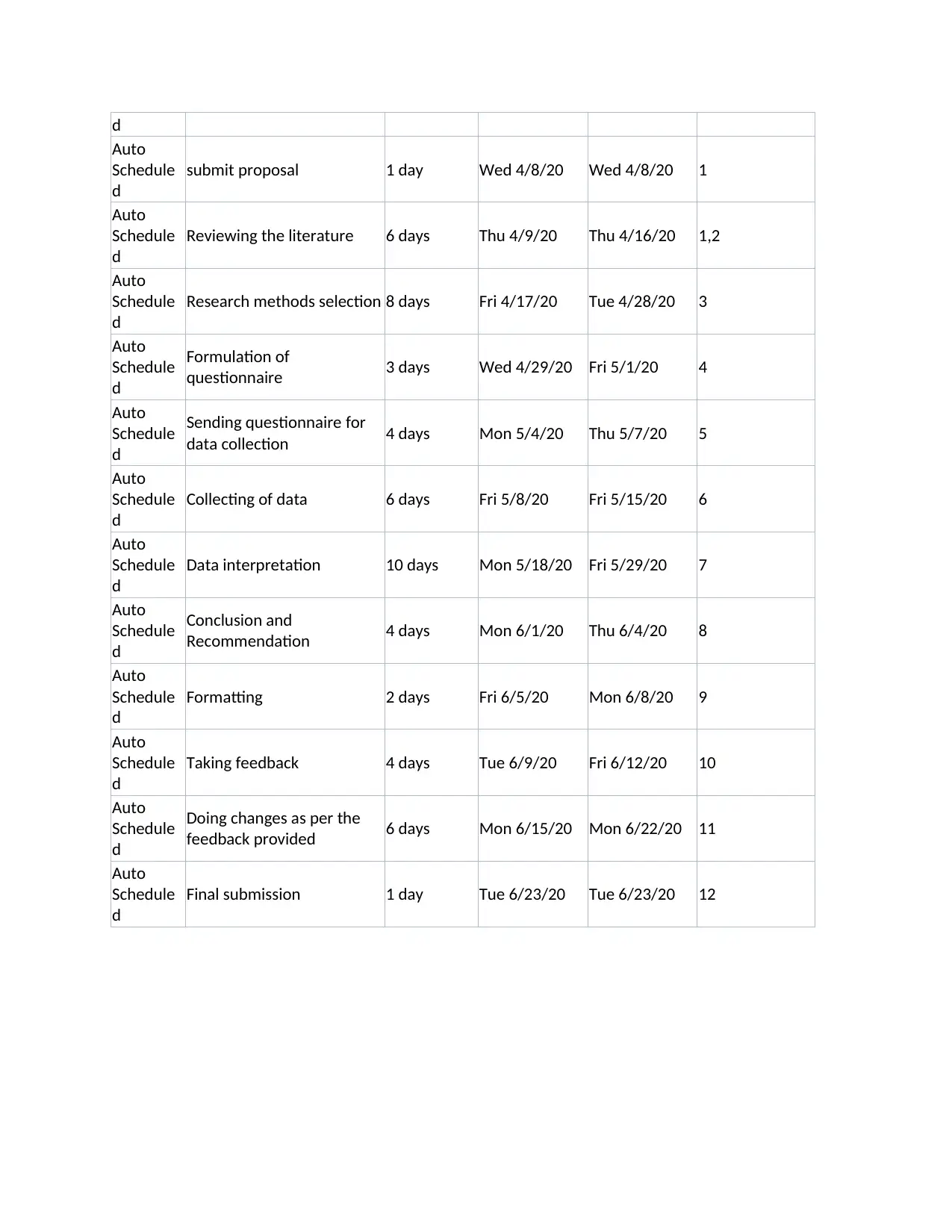
d
Auto
Schedule
d
submit proposal 1 day Wed 4/8/20 Wed 4/8/20 1
Auto
Schedule
d
Reviewing the literature 6 days Thu 4/9/20 Thu 4/16/20 1,2
Auto
Schedule
d
Research methods selection 8 days Fri 4/17/20 Tue 4/28/20 3
Auto
Schedule
d
Formulation of
questionnaire 3 days Wed 4/29/20 Fri 5/1/20 4
Auto
Schedule
d
Sending questionnaire for
data collection 4 days Mon 5/4/20 Thu 5/7/20 5
Auto
Schedule
d
Collecting of data 6 days Fri 5/8/20 Fri 5/15/20 6
Auto
Schedule
d
Data interpretation 10 days Mon 5/18/20 Fri 5/29/20 7
Auto
Schedule
d
Conclusion and
Recommendation 4 days Mon 6/1/20 Thu 6/4/20 8
Auto
Schedule
d
Formatting 2 days Fri 6/5/20 Mon 6/8/20 9
Auto
Schedule
d
Taking feedback 4 days Tue 6/9/20 Fri 6/12/20 10
Auto
Schedule
d
Doing changes as per the
feedback provided 6 days Mon 6/15/20 Mon 6/22/20 11
Auto
Schedule
d
Final submission 1 day Tue 6/23/20 Tue 6/23/20 12
Auto
Schedule
d
submit proposal 1 day Wed 4/8/20 Wed 4/8/20 1
Auto
Schedule
d
Reviewing the literature 6 days Thu 4/9/20 Thu 4/16/20 1,2
Auto
Schedule
d
Research methods selection 8 days Fri 4/17/20 Tue 4/28/20 3
Auto
Schedule
d
Formulation of
questionnaire 3 days Wed 4/29/20 Fri 5/1/20 4
Auto
Schedule
d
Sending questionnaire for
data collection 4 days Mon 5/4/20 Thu 5/7/20 5
Auto
Schedule
d
Collecting of data 6 days Fri 5/8/20 Fri 5/15/20 6
Auto
Schedule
d
Data interpretation 10 days Mon 5/18/20 Fri 5/29/20 7
Auto
Schedule
d
Conclusion and
Recommendation 4 days Mon 6/1/20 Thu 6/4/20 8
Auto
Schedule
d
Formatting 2 days Fri 6/5/20 Mon 6/8/20 9
Auto
Schedule
d
Taking feedback 4 days Tue 6/9/20 Fri 6/12/20 10
Auto
Schedule
d
Doing changes as per the
feedback provided 6 days Mon 6/15/20 Mon 6/22/20 11
Auto
Schedule
d
Final submission 1 day Tue 6/23/20 Tue 6/23/20 12
Paraphrase This Document
Need a fresh take? Get an instant paraphrase of this document with our AI Paraphraser
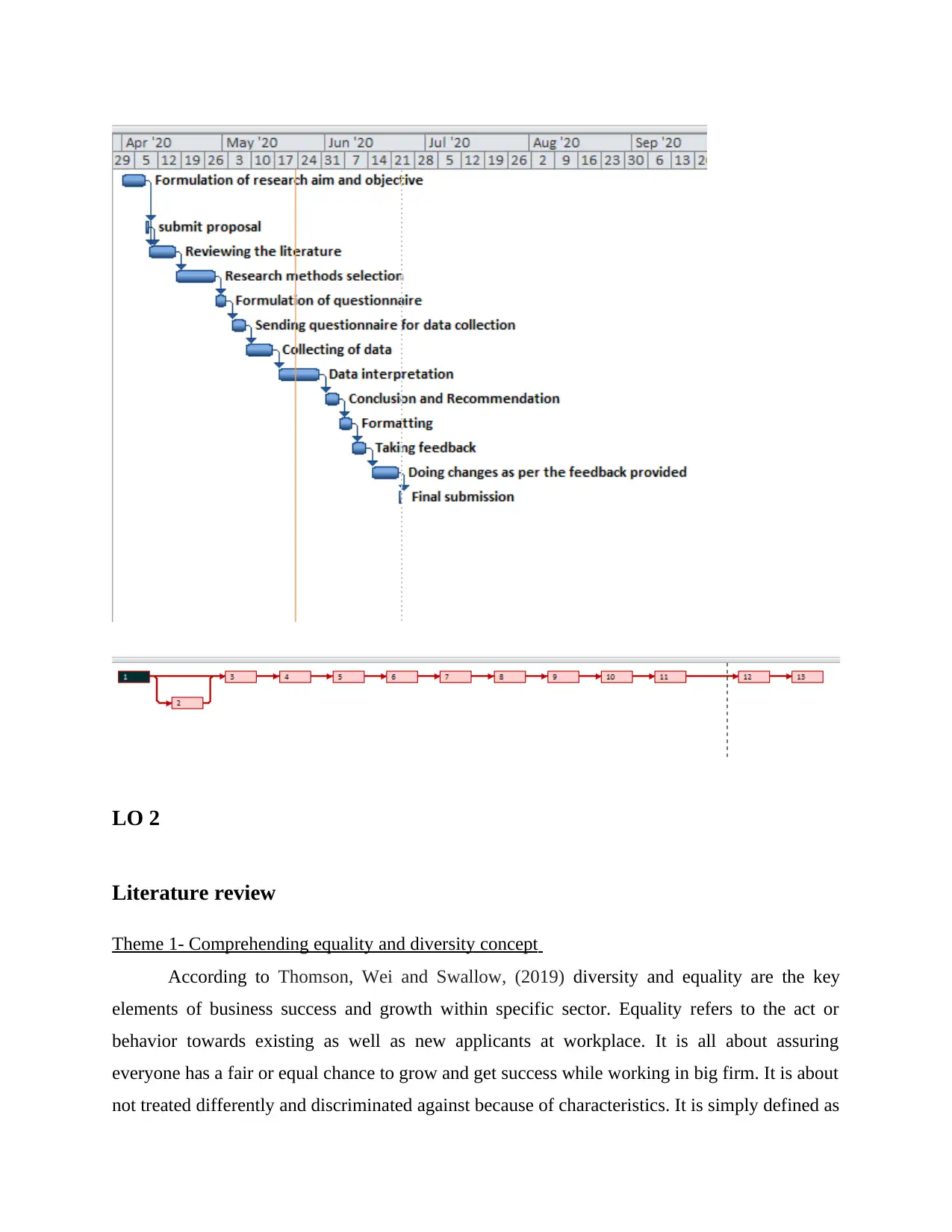
LO 2
Literature review
Theme 1- Comprehending equality and diversity concept
According to Thomson, Wei and Swallow, (2019) diversity and equality are the key
elements of business success and growth within specific sector. Equality refers to the act or
behavior towards existing as well as new applicants at workplace. It is all about assuring
everyone has a fair or equal chance to grow and get success while working in big firm. It is about
not treated differently and discriminated against because of characteristics. It is simply defined as
Literature review
Theme 1- Comprehending equality and diversity concept
According to Thomson, Wei and Swallow, (2019) diversity and equality are the key
elements of business success and growth within specific sector. Equality refers to the act or
behavior towards existing as well as new applicants at workplace. It is all about assuring
everyone has a fair or equal chance to grow and get success while working in big firm. It is about
not treated differently and discriminated against because of characteristics. It is simply defined as
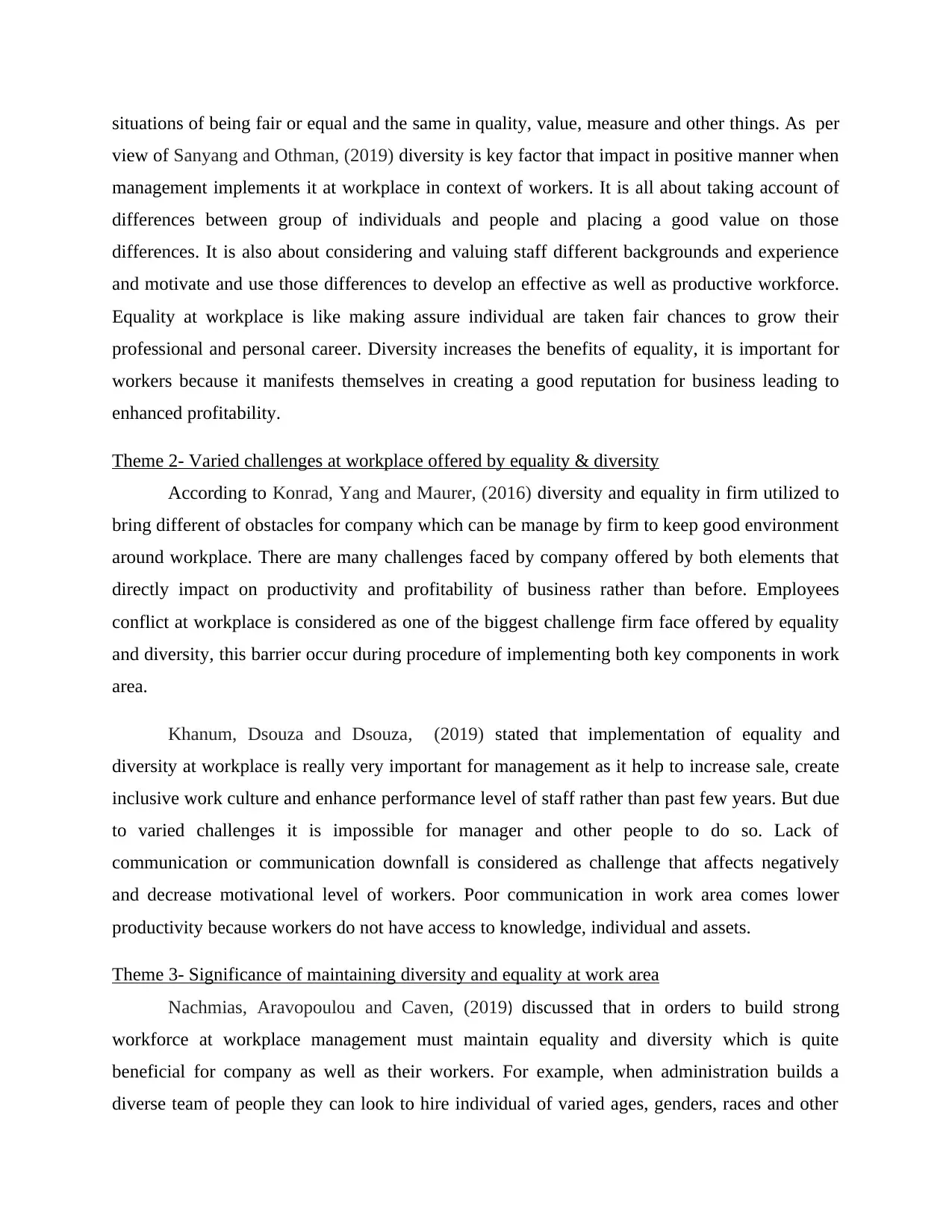
situations of being fair or equal and the same in quality, value, measure and other things. As per
view of Sanyang and Othman, (2019) diversity is key factor that impact in positive manner when
management implements it at workplace in context of workers. It is all about taking account of
differences between group of individuals and people and placing a good value on those
differences. It is also about considering and valuing staff different backgrounds and experience
and motivate and use those differences to develop an effective as well as productive workforce.
Equality at workplace is like making assure individual are taken fair chances to grow their
professional and personal career. Diversity increases the benefits of equality, it is important for
workers because it manifests themselves in creating a good reputation for business leading to
enhanced profitability.
Theme 2- Varied challenges at workplace offered by equality & diversity
According to Konrad, Yang and Maurer, (2016) diversity and equality in firm utilized to
bring different of obstacles for company which can be manage by firm to keep good environment
around workplace. There are many challenges faced by company offered by both elements that
directly impact on productivity and profitability of business rather than before. Employees
conflict at workplace is considered as one of the biggest challenge firm face offered by equality
and diversity, this barrier occur during procedure of implementing both key components in work
area.
Khanum, Dsouza and Dsouza, (2019) stated that implementation of equality and
diversity at workplace is really very important for management as it help to increase sale, create
inclusive work culture and enhance performance level of staff rather than past few years. But due
to varied challenges it is impossible for manager and other people to do so. Lack of
communication or communication downfall is considered as challenge that affects negatively
and decrease motivational level of workers. Poor communication in work area comes lower
productivity because workers do not have access to knowledge, individual and assets.
Theme 3- Significance of maintaining diversity and equality at work area
Nachmias, Aravopoulou and Caven, (2019) discussed that in orders to build strong
workforce at workplace management must maintain equality and diversity which is quite
beneficial for company as well as their workers. For example, when administration builds a
diverse team of people they can look to hire individual of varied ages, genders, races and other
view of Sanyang and Othman, (2019) diversity is key factor that impact in positive manner when
management implements it at workplace in context of workers. It is all about taking account of
differences between group of individuals and people and placing a good value on those
differences. It is also about considering and valuing staff different backgrounds and experience
and motivate and use those differences to develop an effective as well as productive workforce.
Equality at workplace is like making assure individual are taken fair chances to grow their
professional and personal career. Diversity increases the benefits of equality, it is important for
workers because it manifests themselves in creating a good reputation for business leading to
enhanced profitability.
Theme 2- Varied challenges at workplace offered by equality & diversity
According to Konrad, Yang and Maurer, (2016) diversity and equality in firm utilized to
bring different of obstacles for company which can be manage by firm to keep good environment
around workplace. There are many challenges faced by company offered by both elements that
directly impact on productivity and profitability of business rather than before. Employees
conflict at workplace is considered as one of the biggest challenge firm face offered by equality
and diversity, this barrier occur during procedure of implementing both key components in work
area.
Khanum, Dsouza and Dsouza, (2019) stated that implementation of equality and
diversity at workplace is really very important for management as it help to increase sale, create
inclusive work culture and enhance performance level of staff rather than past few years. But due
to varied challenges it is impossible for manager and other people to do so. Lack of
communication or communication downfall is considered as challenge that affects negatively
and decrease motivational level of workers. Poor communication in work area comes lower
productivity because workers do not have access to knowledge, individual and assets.
Theme 3- Significance of maintaining diversity and equality at work area
Nachmias, Aravopoulou and Caven, (2019) discussed that in orders to build strong
workforce at workplace management must maintain equality and diversity which is quite
beneficial for company as well as their workers. For example, when administration builds a
diverse team of people they can look to hire individual of varied ages, genders, races and other
⊘ This is a preview!⊘
Do you want full access?
Subscribe today to unlock all pages.

Trusted by 1+ million students worldwide
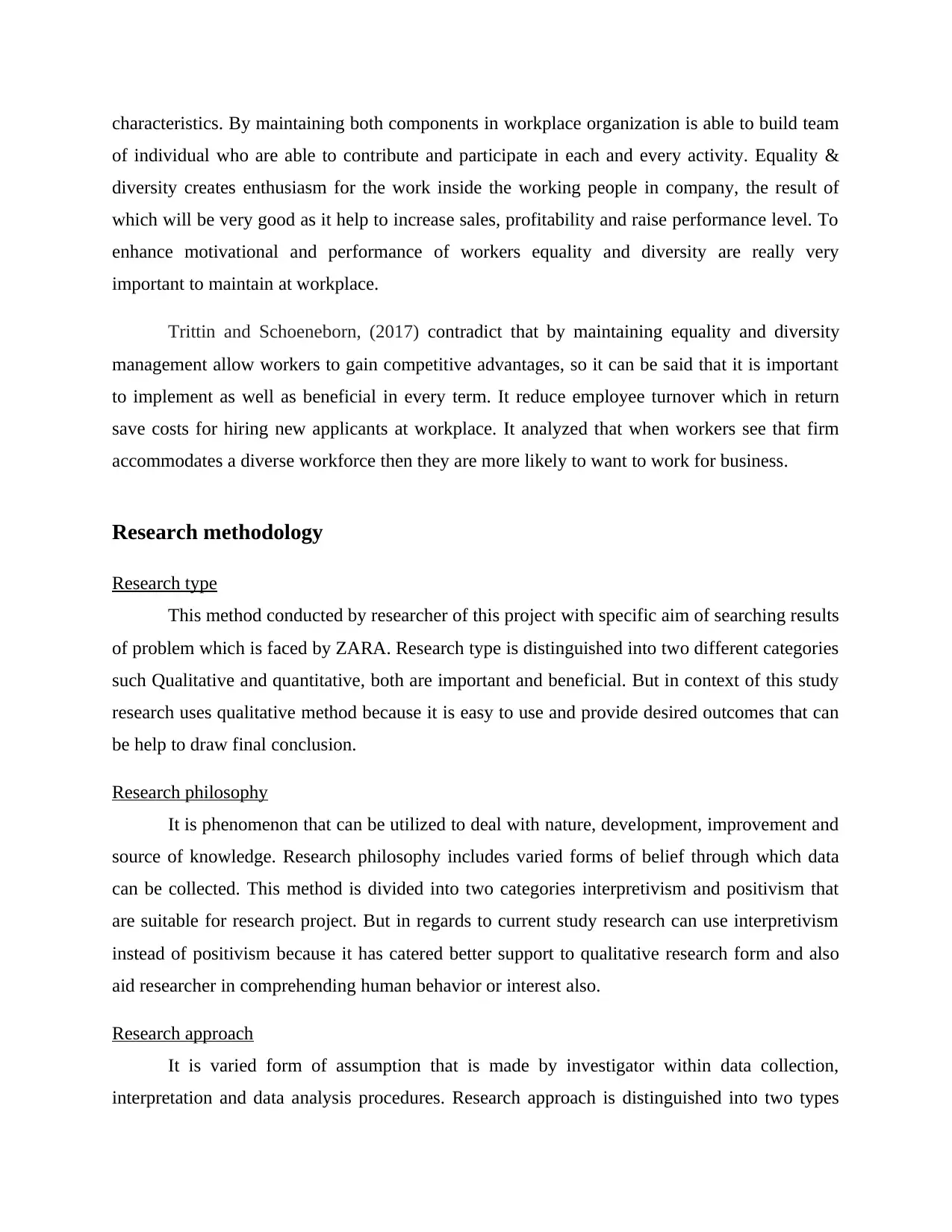
characteristics. By maintaining both components in workplace organization is able to build team
of individual who are able to contribute and participate in each and every activity. Equality &
diversity creates enthusiasm for the work inside the working people in company, the result of
which will be very good as it help to increase sales, profitability and raise performance level. To
enhance motivational and performance of workers equality and diversity are really very
important to maintain at workplace.
Trittin and Schoeneborn, (2017) contradict that by maintaining equality and diversity
management allow workers to gain competitive advantages, so it can be said that it is important
to implement as well as beneficial in every term. It reduce employee turnover which in return
save costs for hiring new applicants at workplace. It analyzed that when workers see that firm
accommodates a diverse workforce then they are more likely to want to work for business.
Research methodology
Research type
This method conducted by researcher of this project with specific aim of searching results
of problem which is faced by ZARA. Research type is distinguished into two different categories
such Qualitative and quantitative, both are important and beneficial. But in context of this study
research uses qualitative method because it is easy to use and provide desired outcomes that can
be help to draw final conclusion.
Research philosophy
It is phenomenon that can be utilized to deal with nature, development, improvement and
source of knowledge. Research philosophy includes varied forms of belief through which data
can be collected. This method is divided into two categories interpretivism and positivism that
are suitable for research project. But in regards to current study research can use interpretivism
instead of positivism because it has catered better support to qualitative research form and also
aid researcher in comprehending human behavior or interest also.
Research approach
It is varied form of assumption that is made by investigator within data collection,
interpretation and data analysis procedures. Research approach is distinguished into two types
of individual who are able to contribute and participate in each and every activity. Equality &
diversity creates enthusiasm for the work inside the working people in company, the result of
which will be very good as it help to increase sales, profitability and raise performance level. To
enhance motivational and performance of workers equality and diversity are really very
important to maintain at workplace.
Trittin and Schoeneborn, (2017) contradict that by maintaining equality and diversity
management allow workers to gain competitive advantages, so it can be said that it is important
to implement as well as beneficial in every term. It reduce employee turnover which in return
save costs for hiring new applicants at workplace. It analyzed that when workers see that firm
accommodates a diverse workforce then they are more likely to want to work for business.
Research methodology
Research type
This method conducted by researcher of this project with specific aim of searching results
of problem which is faced by ZARA. Research type is distinguished into two different categories
such Qualitative and quantitative, both are important and beneficial. But in context of this study
research uses qualitative method because it is easy to use and provide desired outcomes that can
be help to draw final conclusion.
Research philosophy
It is phenomenon that can be utilized to deal with nature, development, improvement and
source of knowledge. Research philosophy includes varied forms of belief through which data
can be collected. This method is divided into two categories interpretivism and positivism that
are suitable for research project. But in regards to current study research can use interpretivism
instead of positivism because it has catered better support to qualitative research form and also
aid researcher in comprehending human behavior or interest also.
Research approach
It is varied form of assumption that is made by investigator within data collection,
interpretation and data analysis procedures. Research approach is distinguished into two types
Paraphrase This Document
Need a fresh take? Get an instant paraphrase of this document with our AI Paraphraser
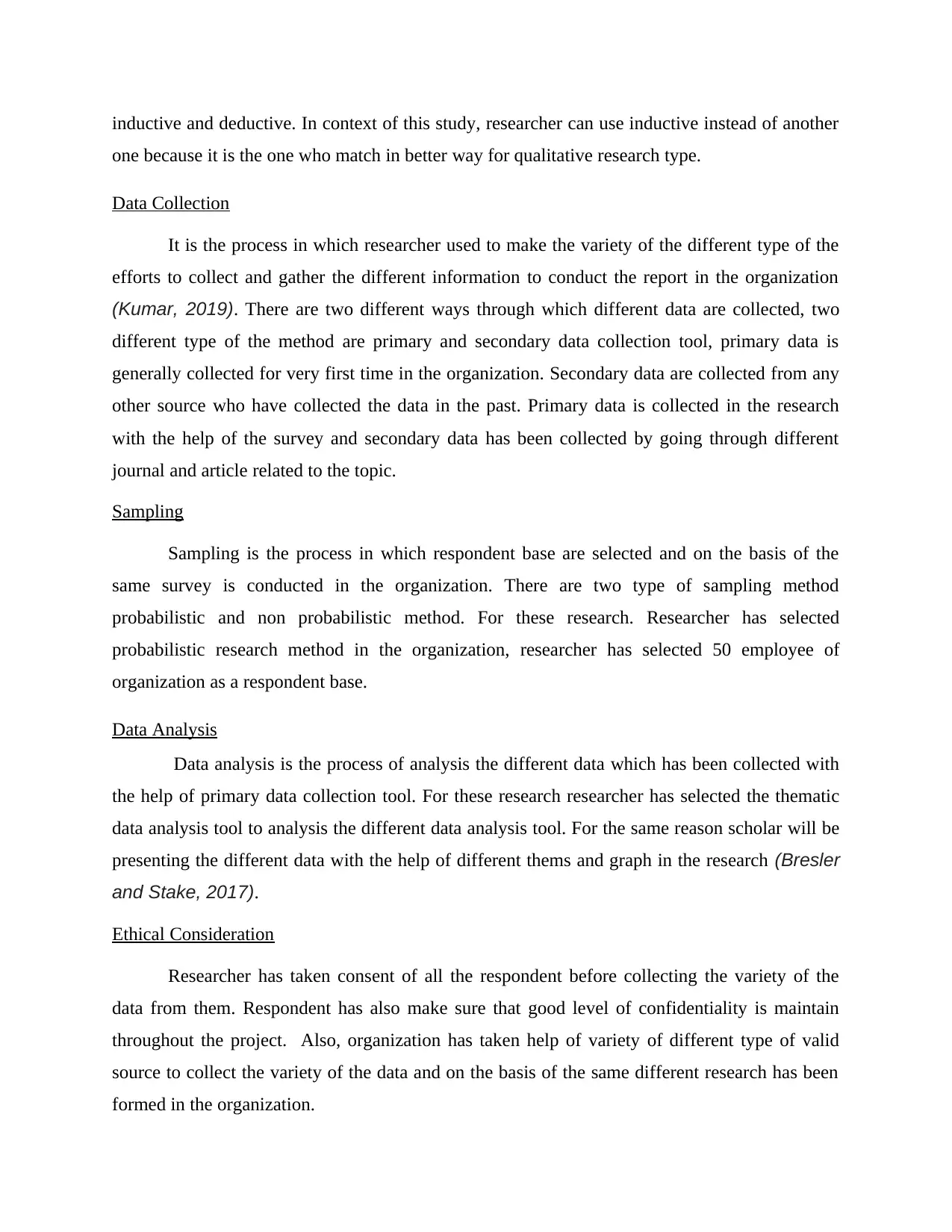
inductive and deductive. In context of this study, researcher can use inductive instead of another
one because it is the one who match in better way for qualitative research type.
Data Collection
It is the process in which researcher used to make the variety of the different type of the
efforts to collect and gather the different information to conduct the report in the organization
(Kumar, 2019). There are two different ways through which different data are collected, two
different type of the method are primary and secondary data collection tool, primary data is
generally collected for very first time in the organization. Secondary data are collected from any
other source who have collected the data in the past. Primary data is collected in the research
with the help of the survey and secondary data has been collected by going through different
journal and article related to the topic.
Sampling
Sampling is the process in which respondent base are selected and on the basis of the
same survey is conducted in the organization. There are two type of sampling method
probabilistic and non probabilistic method. For these research. Researcher has selected
probabilistic research method in the organization, researcher has selected 50 employee of
organization as a respondent base.
Data Analysis
Data analysis is the process of analysis the different data which has been collected with
the help of primary data collection tool. For these research researcher has selected the thematic
data analysis tool to analysis the different data analysis tool. For the same reason scholar will be
presenting the different data with the help of different thems and graph in the research (Bresler
and Stake, 2017).
Ethical Consideration
Researcher has taken consent of all the respondent before collecting the variety of the
data from them. Respondent has also make sure that good level of confidentiality is maintain
throughout the project. Also, organization has taken help of variety of different type of valid
source to collect the variety of the data and on the basis of the same different research has been
formed in the organization.
one because it is the one who match in better way for qualitative research type.
Data Collection
It is the process in which researcher used to make the variety of the different type of the
efforts to collect and gather the different information to conduct the report in the organization
(Kumar, 2019). There are two different ways through which different data are collected, two
different type of the method are primary and secondary data collection tool, primary data is
generally collected for very first time in the organization. Secondary data are collected from any
other source who have collected the data in the past. Primary data is collected in the research
with the help of the survey and secondary data has been collected by going through different
journal and article related to the topic.
Sampling
Sampling is the process in which respondent base are selected and on the basis of the
same survey is conducted in the organization. There are two type of sampling method
probabilistic and non probabilistic method. For these research. Researcher has selected
probabilistic research method in the organization, researcher has selected 50 employee of
organization as a respondent base.
Data Analysis
Data analysis is the process of analysis the different data which has been collected with
the help of primary data collection tool. For these research researcher has selected the thematic
data analysis tool to analysis the different data analysis tool. For the same reason scholar will be
presenting the different data with the help of different thems and graph in the research (Bresler
and Stake, 2017).
Ethical Consideration
Researcher has taken consent of all the respondent before collecting the variety of the
data from them. Respondent has also make sure that good level of confidentiality is maintain
throughout the project. Also, organization has taken help of variety of different type of valid
source to collect the variety of the data and on the basis of the same different research has been
formed in the organization.
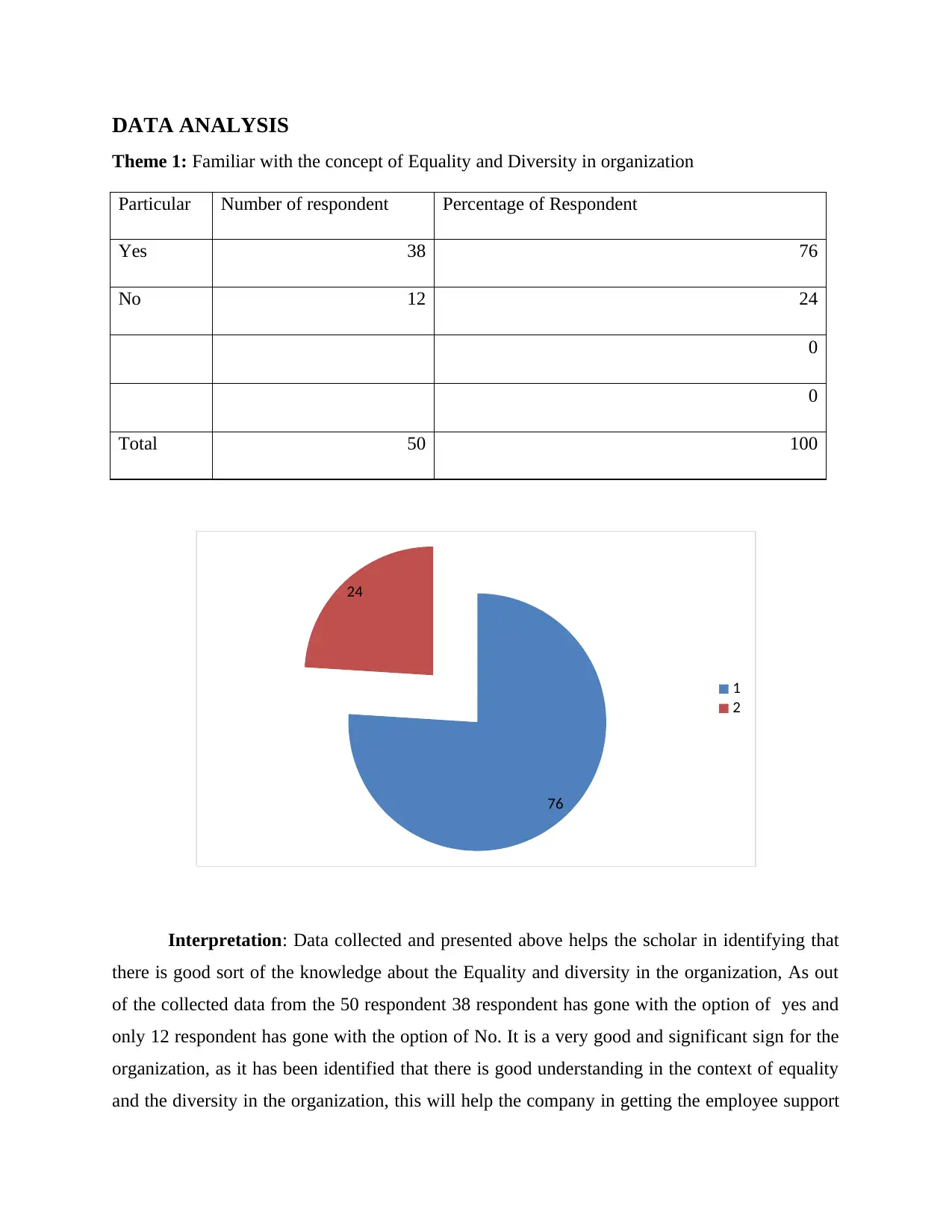
DATA ANALYSIS
Theme 1: Familiar with the concept of Equality and Diversity in organization
Particular Number of respondent Percentage of Respondent
Yes 38 76
No 12 24
0
0
Total 50 100
76
24
1
2
Interpretation: Data collected and presented above helps the scholar in identifying that
there is good sort of the knowledge about the Equality and diversity in the organization, As out
of the collected data from the 50 respondent 38 respondent has gone with the option of yes and
only 12 respondent has gone with the option of No. It is a very good and significant sign for the
organization, as it has been identified that there is good understanding in the context of equality
and the diversity in the organization, this will help the company in getting the employee support
Theme 1: Familiar with the concept of Equality and Diversity in organization
Particular Number of respondent Percentage of Respondent
Yes 38 76
No 12 24
0
0
Total 50 100
76
24
1
2
Interpretation: Data collected and presented above helps the scholar in identifying that
there is good sort of the knowledge about the Equality and diversity in the organization, As out
of the collected data from the 50 respondent 38 respondent has gone with the option of yes and
only 12 respondent has gone with the option of No. It is a very good and significant sign for the
organization, as it has been identified that there is good understanding in the context of equality
and the diversity in the organization, this will help the company in getting the employee support
⊘ This is a preview!⊘
Do you want full access?
Subscribe today to unlock all pages.

Trusted by 1+ million students worldwide
1 out of 30
Related Documents
Your All-in-One AI-Powered Toolkit for Academic Success.
+13062052269
info@desklib.com
Available 24*7 on WhatsApp / Email
![[object Object]](/_next/static/media/star-bottom.7253800d.svg)
Unlock your academic potential
Copyright © 2020–2025 A2Z Services. All Rights Reserved. Developed and managed by ZUCOL.





